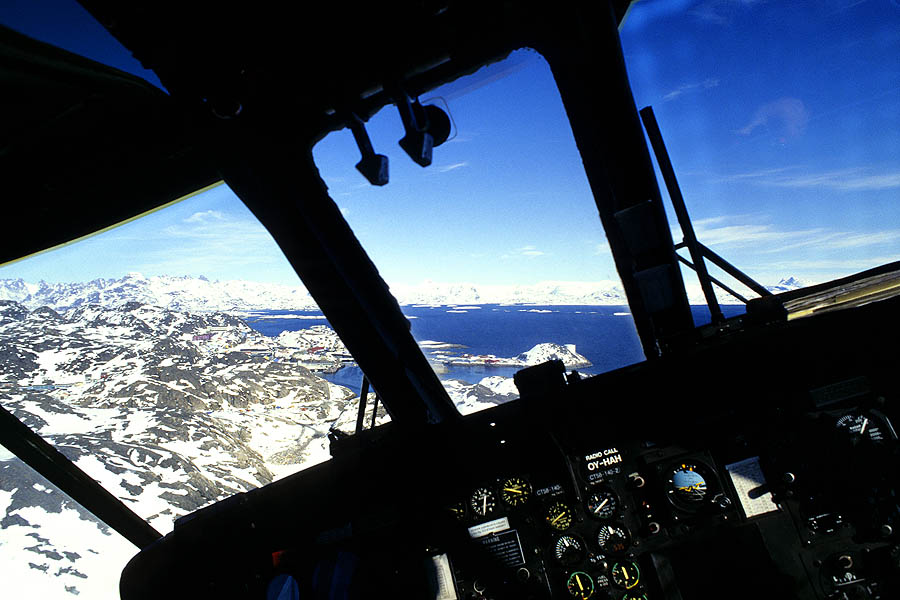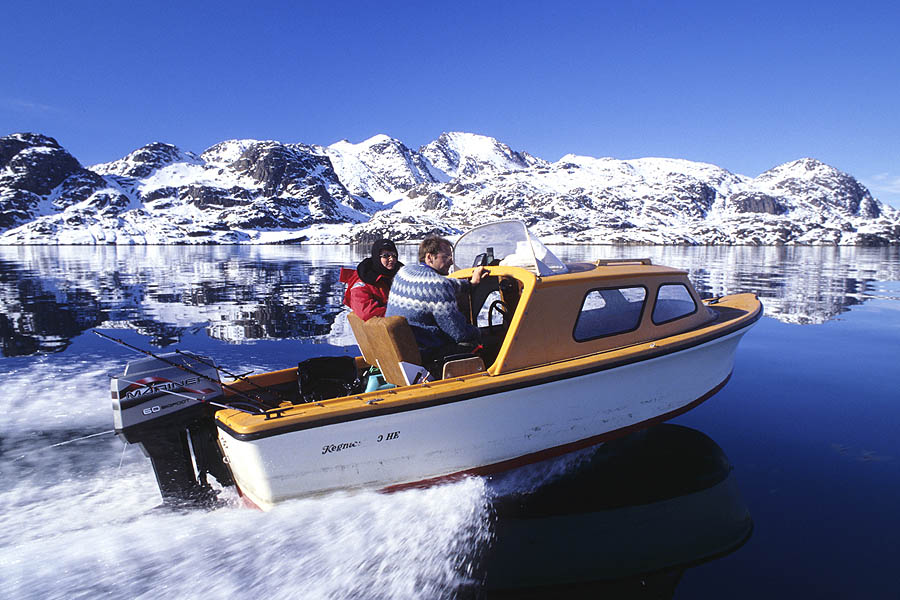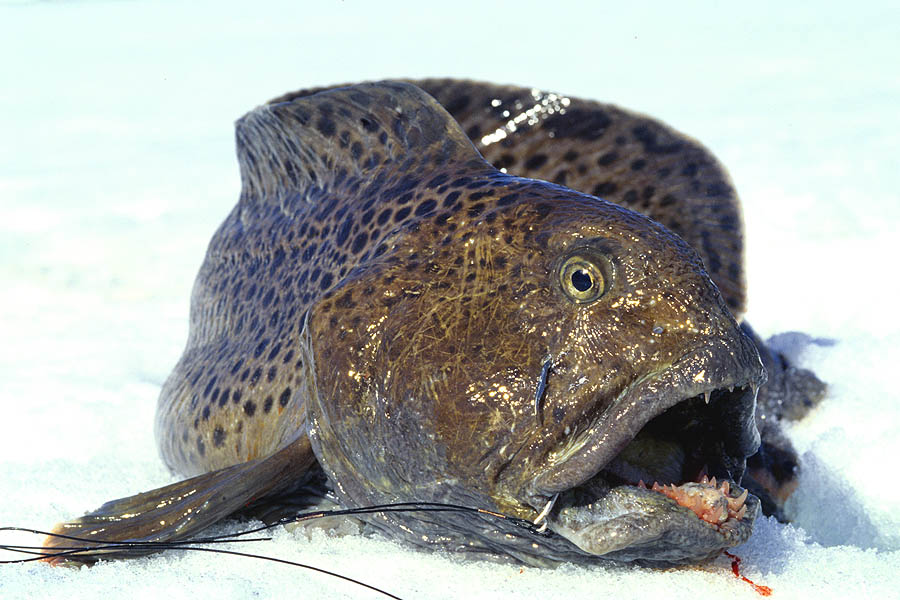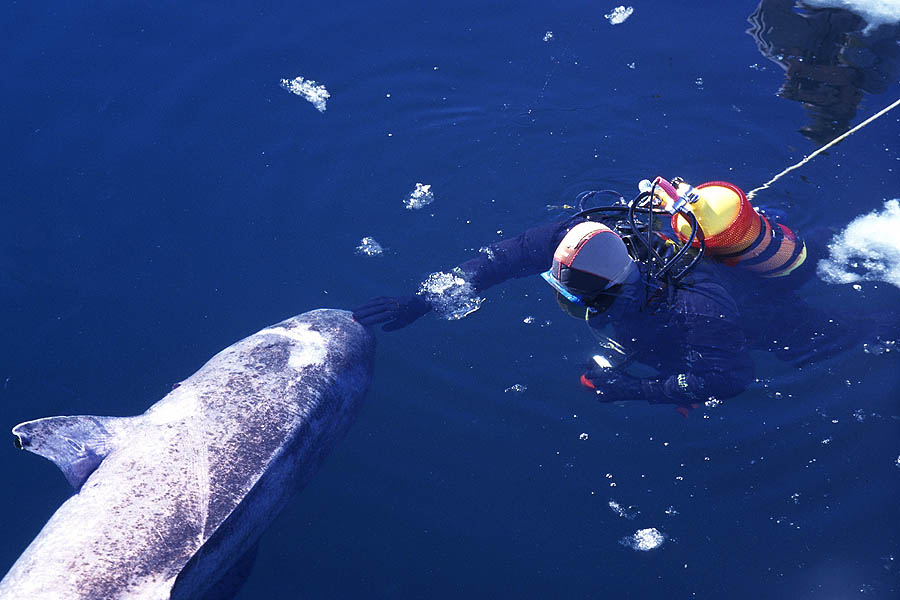 (1999) The strong Fireline cuts the icy water and three sets of eyes stare in expectation into the blue-green void. My heart skips a beat when a huge greyish mass transforms into a weird looking fish of more than 10 feet in length. At last - we have succeeded in hooking one of the "sleepers"...
(1999) The strong Fireline cuts the icy water and three sets of eyes stare in expectation into the blue-green void. My heart skips a beat when a huge greyish mass transforms into a weird looking fish of more than 10 feet in length. At last - we have succeeded in hooking one of the "sleepers"...
Full of adventure in our veins, Niels, Morten and I descend from the Greenland Air Sikorsky helicopter. We are in Maniitsoq, Western Greenland, standing on a small hilltop overlooking the most wonderful little Inuit village. Everything looks promising and we pray that what we see is what we get: Sunshine, fresh air, clear weather, snowy mountains, arctic birds, ice-blue fiords and water looking like a crystal mirror.
The mission is: Greenland sleeper shark. An ITV film crew wanted to do a documentary on this virtually unknown giant shark, and we were supposed to catch it – a pretty good deal, all together!
It was hard to comprehend that it was only three weeks since Niels told us about this trip and its purpose. Three weeks to sort out everything about the fishing tackle, clothing, travel itinerary and preparations for the fishing itself. While Niels from Team Arctic took care of the travel arrangements and fishing preparations, and Morten took care of the fishing tackle and clothing, I just bit my nails and managed to take care of the last minute panic shopping.
The Greenland sleeper shark is one of the biggest shark species in the world. It reaches 8 metres in length and can weigh up to 2 tons. The standing sport-fishing record for this shark is 775 kg - not very big in fact, considering its potential.
As one can make out from its name, it is best known for its slowness. Its scientific name is Somniosus microcephalus, which means "the sleepy one with the small head". The shark lives in the Arctic Ocean and the North Atlantic.
The sleeper shark is not a threat to people, but just about anything else moving around, in, or on the water, has a good chance of ending up in its belly. It is a scavenger, hunter and even cannibal. Old stories tell us about sleeper sharks that were caught, where the stomach contents were truly astonishing - one shark contained a whole reindeer (without antlers, though), in another was a huge seal the size of an oxen, plus 14 cod. In addition to this, sleeper sharks have eaten delicacies such as all sorts of birds, dogs, whales, many types of fish and corals - and even a ram’s head has been found in one of these beasts.
The Greenland sleeper shark is usually infested with a small parasitic crustacean, which feeds on the cells of its eyes, eventually blinding the fish. But as with so many things in nature, there are natural compensations, and in this case the little critters are fluorescent, which is alluring to fish in the dark depths, thereby providing better access to food for the shark.
For the initial 4 days we fished and baited by the buoys, where our local contacts from Maniitsoq had pre-baited the previous couple of weeks. These four pre-baiting spots were situated at depths ranging from 30 to 250 metres of water.
On the first day, we had only fished for half an hour, when a fish took the huge bait - a piece of seal skin/blubber. I waited what felt like an eternity before I struck. There was contact with something very big for a few seconds - and then nothing. To be quite honest, I must have struck too soon. Anyway, we were all psyched up now, and held our rods in utter anticipation. No more sharks took the baits that day - and neither the following couple of days. We did manage to catch a spotted wolfish, though.
Everything else was bliss, though - the loveliest surroundings, beautiful weather and countless birds. We baited up every day at the buoys with a rubby-dubby made of finely chopped rotten seal meat and blubber, seal blood, rotten pieces of seal meat/blubber, lumpfish carcasses and intestines, and occasionally a whole skinned and rotten seal. This is without a shadow of a doubt the most revolting mess I have ever put my hands into – even when using rubber gloves.
Then the film crew arrived. They were very keen on getting started in the brilliant weather, but we, of course, didn’t have much in the way of a giant shark. Therefore Team Arctic and the film crew decided to put out a reward to the local fishermen for a big shark: UK£ 400 for the first shark over 2 metres, and UK£ 900 for the first over 4 metres. That certainly helped!
Already by early the next morning a local had caught a big shark weighing well over 250 kg, and easily exceeding the 2 metres. It was caught just a few hundred yards outside the village harbour...
 Thus, we spent the day filming and photographing. The film crew had set their minds to film the shark in an environment as close to its natural habitat as possible, and preferably at a location with an ice covering on the water. Sunshine and ice don’t mix very well for longer periods of time, but we managed to find a small, enclosed bay with an area covered by 20 cm "thin" ice. It was with a great deal of hesitation that we first stepped onto that creaking surface, and especially when we had to drag the big monster of a shark up as well. But fortunately, we had no close encounters with the icy waters below.
Thus, we spent the day filming and photographing. The film crew had set their minds to film the shark in an environment as close to its natural habitat as possible, and preferably at a location with an ice covering on the water. Sunshine and ice don’t mix very well for longer periods of time, but we managed to find a small, enclosed bay with an area covered by 20 cm "thin" ice. It was with a great deal of hesitation that we first stepped onto that creaking surface, and especially when we had to drag the big monster of a shark up as well. But fortunately, we had no close encounters with the icy waters below.
During the filming, more local fishermen arrived with sharks. Another two of them looked forward to infinite fame and stardom, and these were caught on hand-line and baited pirk. No small feat considering the size of the biggest fish, which weighed in the region of 400 kg.
The film crew seemed very pleased with everything. They filmed both above and below the ice, eventually releasing the shark back into its natural environment.
These films were shown on ITV Channel at primetime, on Discovery Channel, and also a couple of European channels, under the name "Giants". It is a series about the world's largest animals including fish, insects, birds and mammals.
The next day the film crew wanted to do the last bits of filming on the ice (which had inevitably become even smaller and thinner). Niels, Morten and I decided to go fishing instead, and that proved a very good idea.
We had come to know about incidents where local hunters had left seal remains on an ice floe, and subsequently a couple of sharks had managed to tip the ice floe to get the meat into the water. And we had ourselves seen sharks in the surface layers, when we baited with rubby-dubby - the oils from the blubber floated to the surface, and undoubtedly tempted the sharks. So what would be more natural than to fish for them on the surface when they showed up?
We tried, and Niels had some success. With no lead attached to the rig, Niels cast to a shark on the surface, and let the bait sink slowly. The shark finally took the bait after a while, and Niels let the fish swim with the bait for at least 3 minutes before striking - and the fish was hooked. Niels’ 50 lb rod bent right around under the immense pressure of the giant leaving the scene at a steady pace. We honestly doubted whether fish actually knew it was hooked.
We put a fighting belt and a harness on Niels and set out after the fish. No way were we going to just reel it in. There may be good reasons to call it Sleeper Shark, but in this case it must have been a sleepwalker! We had to drive the boat to the fish and try to make it swim in our direction.
It took 45 minutes of strenuous fighting and sweating before the shark gave in. It surfaced 50 metres from the boat, and from there on it lived up to its name - it became absolutely placid to the point of unconsciousness. Or perhaps it just plain fell asleep…
We tied the more than 3 metres long shark to the boat and carefully went to Maniitsoq harbour, where we had the fish weighed at the fish factory. It weighed 305 kg.
Mission Accomplished!
We ended the trip with a grand buffet at the Maniitsoq Hotel together with the film crew. We had Greenland delicacies including raw marinated whale meat, whale skin, marinated reindeer, marinated musk oxen, seal meat, dried cod and halibut, polar hare, scallops and much, much more.
